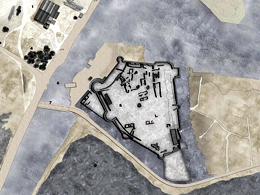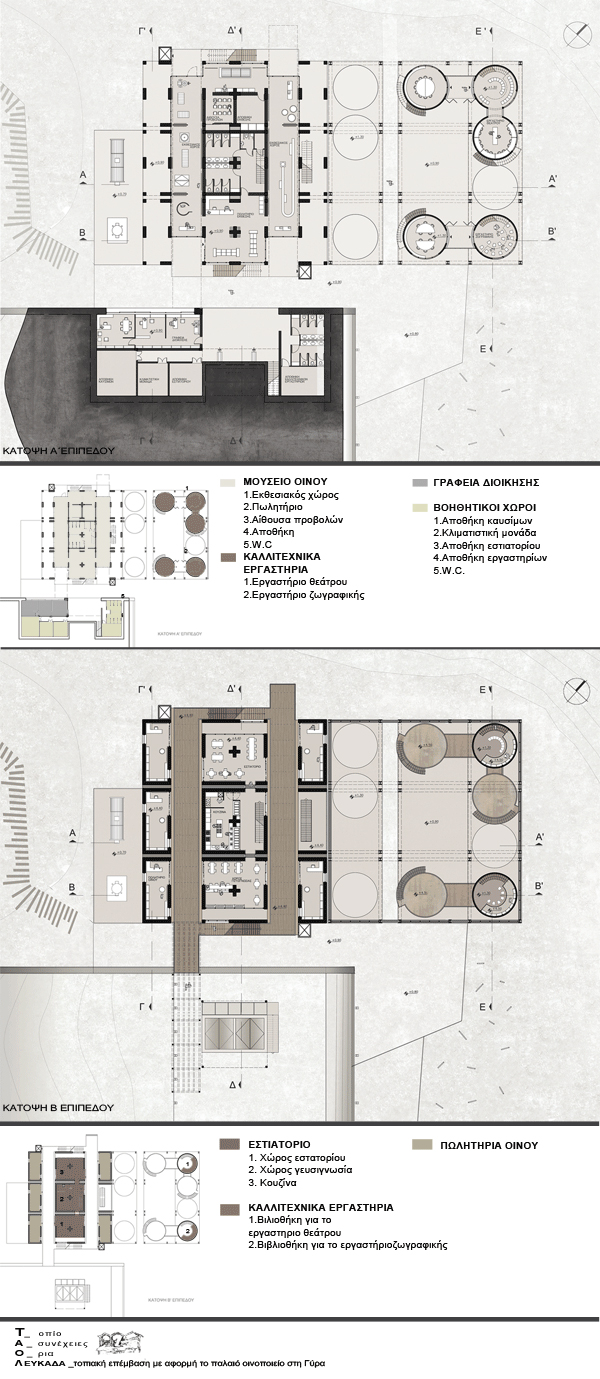STUDENTS PROJECTS
PROJECTS2012

11 May, 2013
LEFKADA. Landscape planning on the occasion of the old winery in Gira
The adaptive reuse of the old industrial building intends to reintegrate it both in the modern way of living, and the unique natural landscape of the region, where it is located.
Students: Georgiadou Athanasia, Krini Eleni, Sklaveniti Eleni
Supervisors: K. Karvountzi, A. Rokas
Advisor: K. Karadimas
School of Architecture NTUA
Date of presentation: March 27 2012
The design in the landscape follows and redefines the existing natural traces and boundaries, with the ultimate goal of balance restoration. The basic stimuli which pointed to the final configuration of the site, emerged from the contrasts in the landscape. The elements taken into account for the analysis and the planning of the landscape are the following: the vegetation, the topography of the site, the waterfront boundary and the existing building structures.

Nowadays, the old winery of TAOL constitutes an unoccupied industrial building, which is not physically incorporated into the landscape of the beach, because of its intense morphology and its industrial functionality. Thus, the character of this region is undefined due to the great contrast between the image of abandonment of the building and its surrounding, and the particular natural beauty of the place. In the beginning of the design process, we try to identify and analyze all those elements that affect the study region. These elements are the following: the capital of the island, the wetland of the lagoon and the sea canal. More particularly, this project aims to enhance the interaction among all these elements and convert the whole study region to a new landmark of the island.

Regarding the lagoon, it is an internationally protected natural area, which faces environmental threats because of its proximity to the town and the increase of tourism. As a consequence, we consider that measures should be shortly taken, in order to protect the wetland. The goal of this proposal is to upgrade the lagoon area, taking into account its environmental sensitivity, avoiding further deterioration by human's intervention and increasing visitors' interest for the whole region. Moreover, in our proposal, taking into consideration the new entrance of the town, we suggest traffic regulations that limit the use of vehicles and enhance the use of bicycle as main means of transportation. Consequently, a thematic circular route is organized around the lagoon, including stations and information points at different locations of ecological or historical interest. In this way, the tour of the lagoon becomes one of the proposed "green routes" on the island, where the visitor is informed about the history and the environmental value of the region, while experiencing the place. As a result, the public participate in a new type of environmental education and Gira turns into an outdoor environmental centre far from a typically organised information building.


In the study area, the existing buildings -the winery and the leisure pavilion- have a dominant attitude over the site, while they are not incorporated into it. The old winery is one of the few samples of industrial architecture on the island and it is also an important part of its history. In contrast, the leisure pavilion, constitutes a building shell, with intense morphology, which has been abandoned during the last decades. Taking into account the specific sensitivity of the environment we propose the adaptive reuse of the building of TAOL. The pavilion is demolished, but its traces on the ground landscape an open-air theatre.

As regards the surrounding of the building, the basic elements taken into account for the analysis and the planning of the landscape, are the vegetation and the topography of the site. The design in the landscape has followed and redefined the existing natural traces and boundaries, with the ultimate goal of balance restoration. In particular, the existing vegetation is supplemented and the dune ecosystem is protected. In contrast to the flatness of the wetland, the artificial hill in the entrance of the building offers to the visitor a wide view of the site. Thus, it is maintained and enhanced by the addition of two lower hillocks to the south of TAOL.
The waterfront boundary is another important element which participates in the landscaping of the region, while the main route is formed in the extension of the road, close to the sea canal. The entrances to the building, the café and the open-air theatre begin radially from this linear route. The penetration of water crosses vertically the linear route and constitutes a limit to our intervention on the site. Moreover, the "entrance" of the sea into the land takes place near the reeds, where "water traces" already exist.

The key elements of the building which are maintained are the following:
1) the rectangular shape
2) the construction grid - the structural system
3) the morphology of the roof
The existing building, could be characterised as a particularly "introvert" construction. However, in contrast to its imposing exterior image, inside, the concrete (cubic permanent structures) and metallic (mobile structures) tanks, compose an interesting synthesis of volumes. In an attempt to turn the building into an extrovert compound, the additions are removed so as to designate the principal volume and the external shell of concrete is punctured. As a result, the wine tanks and the construction system are visible from the external environment and the continuity between the interior and the exterior of the building is achieved.
As for the structure, the tanks of concrete and the metallic ones are preserved, however the rest of the construction system is replaced with a metallic structure that sustains the roof. The new roof has the same morphology with the previous one. The metallic structural system constitutes the intervention to the old concrete core of the building. Furthermore, the antiseismic behavior and the industrial character of the metal reinforce the choice of the material.


Redefining the "concept" of a typical museum, the building, as remnant of the past, narrates its history to the visitor, while its new function brings it back to present. The supposed script of visitors' movement in the building follows the production line, the "wine path" in the old winery. Thus, the main elements of the fixed equipment remain in their places so as to constitute scattered exhibits inside and outside the building.
On the level of the main entrance to the building, which remains the same, the small concrete tanks are converted into shops of local wine. The central tanks are bonded creating a seamless space, the restaurant area of the compound, where the visitors can taste local and traditional eatings. The open air space of the restaurant, where one admires the natural surrounding, is located on the third level, over the concrete tanks. A permanent exhibition of the wine production, as it used to take place in the old winery, is hosted on the ground floor of the building. In the side of the metallic tanks, five of the old wine tanks are maintained and converted into artistic studios for groups of artists acting in the town. Open air exhibitions and other artistic events could take place in the square which is formed among the tanks.


Related articles:
- Winery in Santorini ( 24 November, 2009 )
- Reutilisation of the building T.A.O.L. in Lefkada ( 23 June, 2010 )
- Winery Casa da Torre ( 15 March, 2012 )
- Winery in Nemea ( 01 May, 2012 )
- Mission Hill Family Estate Winery ( 20 October, 2012 )
- meta industrial landscape ( 09 July, 2014 )
- Nemea ( 22 July, 2015 )










